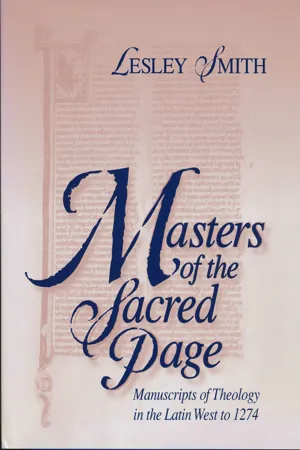
- English
- PDF
- Available on iOS & Android
About This Book
Starting with the premise that the history of a medieval subject cannot be properly written "without recourse to the materials it produced, " Lesley Smith's Masters of the Sacred Page provides an illuminating study of theology in the Middle Ages. She focuses on the dramatic transformations of the discipline in the twelfth century and uses a collection of contemporary manuscripts as a guide to its changes and developments.
Smith points out that the medieval masters of theology had a much wider view of their subject than the modern academic tendency for neatness and division can easily admit, and she places their discipline squarely within the rapidly evolving intellectual and educational context of the twelfth-century university.
Her approach avoids two of the most common weaknesses of modern historical studies of medieval theology. In the first place, those histories have a tendency to be distorted by a reliance on easily available printed editions of medieval texts, the bulk of which are summae and other logical, systematic treatments. This preponderance, however, often reflects the concerns and interests of nineteenth- and twentieth-century editors more than it does the medieval masters. Biblical commentaries, sermons, and manuals for pastoral use have only recently begun to be edited and printed in numbers reflecting their importance and widespread use in the Middle Ages; Smith includes such material in her study.
In the second place, traditional histories have a tendency to remove the study of theology from the actual environment of the medieval university and therefore fail to account for the complex relations between theology, the arts, and the burgeoning disciplines of medicine and law. By refusing to follow this trend, Smith has greatly improved our awareness of the situation of medieval theology.
Using the manuscript books themselves as witnesses, Smith shows how theology competed with other disciplines for students (as well as teachers), how it attempted to define itself, and how it cooperated with other disciplines to foster new development in book technology—and new traditions in the social and intellectual culture of the medieval university.
Frequently asked questions
Information
Table of contents
- Cover
- Half title
- Series page
- Title page
- Copyright
- Contents
- Acknowledgments
- About the Author
- Abbreviations
- Introduction
- List of Plates
- A. The Bible as Theological Tool
- B. Sources
- C. Sentences to Summae
- D. Theology Made Accessible
- Glossary
- Bibliography
- Index
- Index of Manuscripts
- Index of Early Printed Books